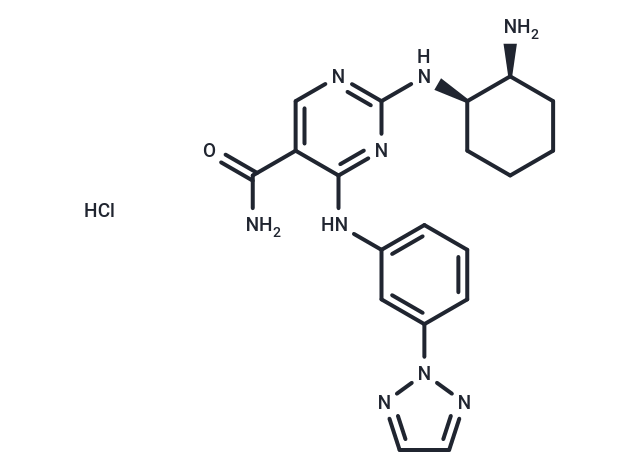Shopping Cart
- Remove All
 Your shopping cart is currently empty
Your shopping cart is currently empty

PRT062607 hydrochloride (P505-15 Hydrochloride) is a selective inhibitor of Syk (IC50: 1 nM). It displays at least 80-fold selectivity for Syk over other kinases.

| Pack Size | Price | Availability | Quantity |
|---|---|---|---|
| 1 mg | $55 | In Stock | |
| 2 mg | $78 | In Stock | |
| 5 mg | $129 | In Stock | |
| 10 mg | $197 | In Stock | |
| 25 mg | $344 | In Stock | |
| 50 mg | $527 | In Stock | |
| 200 mg | $997 | In Stock | |
| 1 mL x 10 mM (in DMSO) | $142 | In Stock |
| Description | PRT062607 hydrochloride (P505-15 Hydrochloride) is a selective inhibitor of Syk (IC50: 1 nM). It displays at least 80-fold selectivity for Syk over other kinases. |
| Targets&IC50 | FGR:81 nM (cell free), MLK1:88 nM (cell free), Syk:1 nM (cell free) |
| In vitro | PRT062607 (P505-15) is a highly specific and potent inhibitor of purified Syk (IC50 1-2 nM). In human whole blood, P505-15 potently inhibited B cell antigen receptor-mediated B cell signaling and activation (IC50 0.27 and 0.28 μM, respectively) and Fcε receptor 1-mediated basophil degranulation (IC50 0.15 μM). Similar levels of ex vivo inhibition were measured after dosing in mice (Syk signaling IC50 0.32 μM) [1]. P505-15 abrogated the pro-survival effect of anti-IgM and induced CLL cell apoptosis. Treatment with P505-15 (2 mM/mL) decreased CLL cell viability to 62.9 ± 5.1% after 48 hours. Treatment with lower concentrations of PRT318 and P505-15 also reduced the viability of CLL cells [2]. |
| In vivo | Demonstrating a rapid onset of action, 0.5 h after oral administration of 30 mg/kg P505-15, Syk activity was reduced by 80% and nearly completely suppressed for the next 5 h relative to vehicle control-treated mice. Syk activity remained more than 60% suppressed for the first 8 h postdosing, returning to levels of vehicle control treatment by 24 h. At the lower dose of 15 mg/kg, more than 50% suppression of Syk activity was observed between 2 and 6 h after oral administration of the compound [1]. |
| Kinase Assay | Potency of Syk inhibition was determined by using a fluorescence resonance energy transfer (FRET) assay. The extent of substrate phosphorylation by Syk was measured in the presence of various P505-15 concentrations. Syk activity was determined by a fluorescent antibody specific for phosphorylated tyrosine by using the increase of FRET. Twelve concentrations were tested for dose response. Specificity and potency of kinase inhibition was determined by evaluation of P505-15 in the Millipore KinaseProfiler panel of 270 independent purified kinase assays. For profiling, P505-15 was tested in duplicate at two concentrations at a fixed concentration of ATP. Subsequently, IC50 determinations using the radioactive assays were carried out at an ATP concentration optimized for each individual kinase. All radioactive ATP incorporation enzyme assays were performed at Millipore UK [1]. |
| Cell Research | NLC co-cultures were established by suspending PBMC from patients with CLL in complete RPMI medium with 10% fetal bovine serum and penicillin-streptomycin-glutamine to a concentration of 107 cells/mL (total 2 mL). Cells were incubated for 14 days in 24-well plates as previously described. To evaluate whether the Syk inhibitors PRT318 and P505-15 could overcome the protective effect of NLC, CLL cells were cultured under standardized conditions on NLC or in suspension, in the presence or absence of PRT318 and P505-15. At the indicated time points, CLL cells were collected and assayed for cell viability as previously described [2]. |
| Animal Research | All animal studies were performed in strict accordance with the Institutional Animal Care and Use Committee ethical guidelines. Female BALB/c mice received a single oral dose of 15 or 30 mg/kg P505-15 and were anesthetized with a subcutaneous ketamine cocktail, and blood was harvested via cardiac puncture at 0.5, 1, 2, 3, 4, 5, 6, 8, and 24 h postdose, (n = 3/time point; n = 8 vehicle controls). Blood was dispensed into three heparin-containing tubes, one for determination of drug concentration and the remaining two for ex vivo stimulation with isotype control or anti-mouse IgD antibody for 10 min. Blood was processed for intracellular phospho-flow cytometry to evaluate BCR signaling as described earlier; mouse B cells were detected by using CD45R-B220 PerCP-conjugated antibody. Plasma samples were analyzed for P505-15 concentration by using a liquid chromatography tandem mass spectrometer. The analytical range was 2 to 5000 ng/ml [1]. |
| Alias | PRT062607 (P505-15, BIIB057) HCl, P505-15 Hydrochloride |
| Molecular Weight | 429.91 |
| Formula | C19H23N9O·HCl |
| Cas No. | 1370261-97-4 |
| Smiles | Cl.N[C@H]1CCCC[C@H]1Nc1ncc(C(N)=O)c(Nc2cccc(c2)-n2nccn2)n1 |
| Relative Density. | no data available |
| Storage | Powder: -20°C for 3 years | In solvent: -80°C for 1 year | Shipping with blue ice. | |||||||||||||||||||||||||||||||||||
| Solubility Information | Ethanol: < 1 mg/mL (insoluble or slightly soluble) H2O: 79 mg/mL (183.76 mM), Sonication is recommended. DMSO: 45 mg/mL (104.67 mM), Sonication is recommended. | |||||||||||||||||||||||||||||||||||
Solution Preparation Table | ||||||||||||||||||||||||||||||||||||
DMSO/H2O
| ||||||||||||||||||||||||||||||||||||

Copyright © 2015-2025 TargetMol Chemicals Inc. All Rights Reserved.